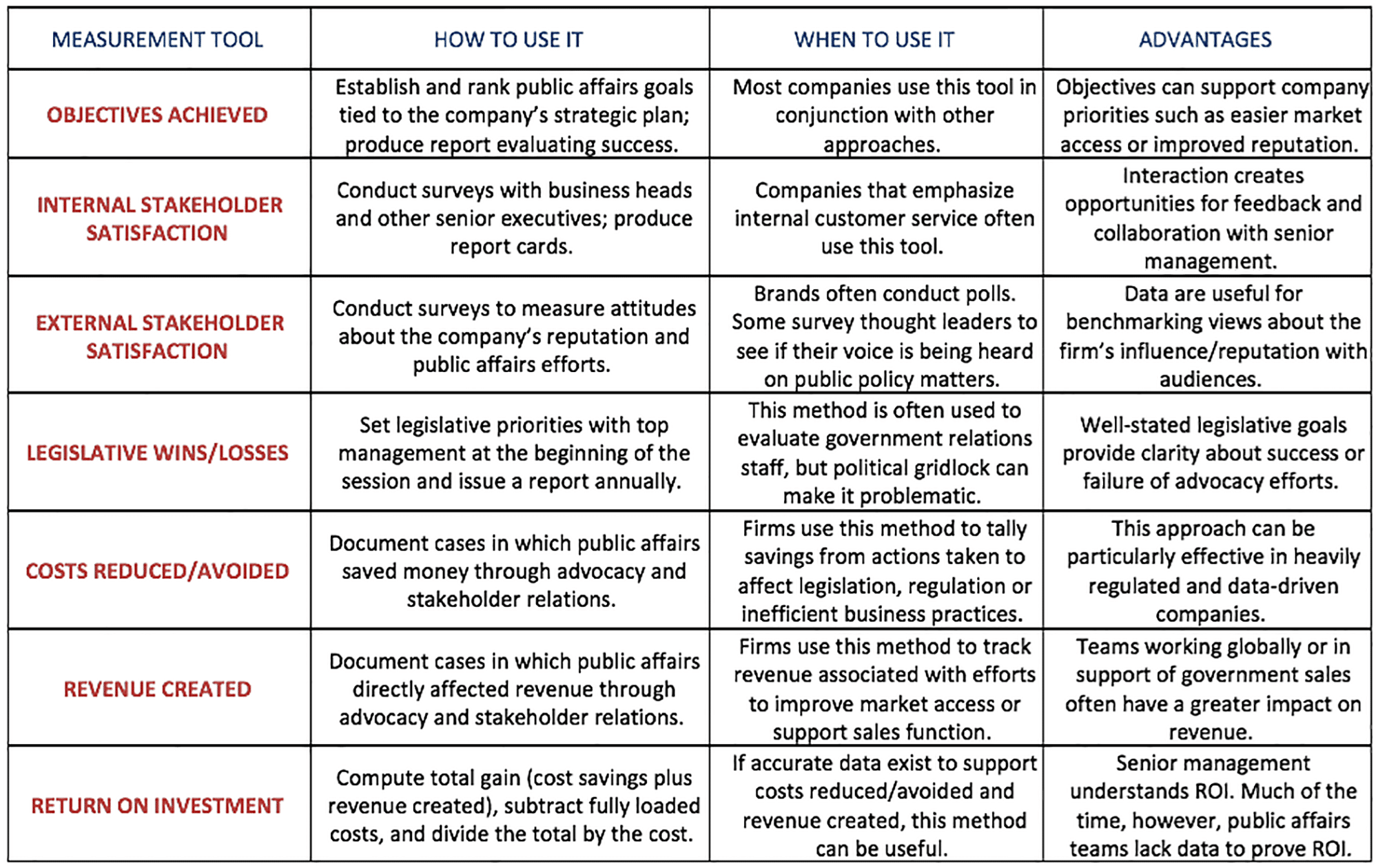How to Measure the Value of Public Affairs
September 2022
Business functions such as manufacturing, logistics, purchasing, or sales are data-driven, which makes them ideal candidates for using performance management systems. But public affairs functions often struggle to measure performance.
Here’s why:
- Public affairs objectives are often long term, which means that annual data showing success or failure may not be available.
- Many objectives involve managing risks rather than taking actions to capitalize on business opportunities.
- Strategies to achieve goals are often executed in concert with other parties, such as trade associations.
- Objectives often shift during the year, particularly when dealing with legislative bodies: A bill that looks onerous in January may look like a best-case scenario in November.
- Many public affairs strategies are difficult to evaluate because they are not transactional — they involve engaging stakeholders and building alliances.
Nevertheless, it is possible to develop performance management systems for public affairs. The keys are to establish a clear value proposition, tie measurement/evaluation to business units, reflect the corporate culture, and focus on impact rather than activity.
UNDERSTANDING THE VALUE PROPOSITION
Whether one works for a large corporation, a small business, a nonprofit or a government agency, it’s always a good idea to develop value propositions for all organizational functions. These propositions define the role of each department in helping the organization achieve its goals.
Reaching agreement on a value proposition not only provides clarity about the function’s role; it also ties public affairs more closely to the business and keeps measurement discussions focused on progress made to achieve objectives.
What are the components of a good value proposition? Some companies focus on their freedom to operate and avoiding unnecessary costs, while others emphasize gaining market advantage, providing superior internal service, or improving the firm’s speed and efficiency.
Public affairs may be described as a function that seeks to minimize political and reputation risks. In other companies, public affairs may be described as an initiator of opportunities to open new markets, forge strong stakeholder relationships and improve the company’s reputation.
Caterpillar, a major American machinery and engine manufacturer, states its government affairs value proposition this way:
“The actions taken by governments around the world can have a significant impact — both positive and negative — on Caterpillar, our employees, our dealers, suppliers and customers. We advocate for policies, agreements, legislation and regulations that enable us to help our customers build a better world.”
Pfizer, a large pharmaceutical manufacturer, explains how public policy engagement affects the firm’s ability to meet patient needs and provide shareholder value.
“Essential aspects of our business are being challenged by barriers to access, counterfeits, illegal importation, and challenges to intellectual property protection. For this reason, we actively participate in public policy dialogues to explain our perspectives.”
Whether a value proposition is general or specific, it can serve to increase understanding of the intrinsic worth of the public affairs function.
CREATING A MEASUREMENT SYSTEM
Once the value proposition has been established, a measurement system should be developed to evaluate the effectiveness of the public affairs department. This system should also help the company assess whether the department has set priorities properly and devoted the right resources to each priority. It is not intended to serve as merely a justification for the department’s existence but, rather, as a way to track improvement.
Different companies use different measurement processes to monitor progress and performance.
Management metrics should reflect value drivers (e.g., freedom to operate, cost avoidance or market opportunity) and speak the language of senior management. For example, a chief financial officer may not understand lobbying or coalition-building, but she will certainly appreciate efforts to help the corporation avoid unnecessary costs. A general counsel may not have legislative experience, but he can relate to the need to identify and manage risks.
When establishing measurement metrics, it’s also important to make sure they reflect a company’s culture. If senior management is numbers-oriented, for example, then most metrics ought to be quantitative. In this case, a public affairs department should make every effort to track costs avoided or reduced, or revenue created.
But a company that devotes much of its resources to advancing its brands or reputation will probably prefer metrics with a qualitative analysis. Examples include internal/external stakeholder satisfaction and public perception surveys.
Many companies still spend too much time counting their actions, rather than tracking the impact of those actions. Inputs are process-oriented steps that may include visits to Capitol Hill, meetings with community leaders, checks written to charities or the number of PAC eligibles solicited. Outcomes are results-oriented and can take many forms: legislative wins and losses, regulatory policy rulings, shifts in public opinion or changes in stakeholder behavior.
There are times when a high level of inputs is correlated with positive outcomes. Key performance indicators (KPIs) are a set of quantifiable metrics that gauge the performance of a team in achieving its strategic and operational objectives. KPIs are widely used in sales, finance, supply chain management and other business functions. For example, companies may monitor return on invested capital, profit per employee, customer acquisition cost ratios or backorder rates.
It is difficult to identify meaningful KPIs for public affairs departments because of a lack of relevant data, inadequate sample size and the non-transactional nature of the work. Trying to compute a ratio of congressional office visits to favorable votes would be a fool’s errand. So would any attempt to measure stakeholder outreach per employee.
Nevertheless, companies have made headway in recognizing ways to connect inputs to outcomes and, in some cases, to incorporate KPIs. High employee participation levels for grassroots campaigns, for instance, can influence undecided legislators and help solidify political supporters. But, in addition, a robust grassroots program or corporate PAC can demonstrate that employees understand policy issues and are willing to speak up on the company’s behalf. For a corporation that has made it a priority to engage employees on multiple levels, these activities feed into human resources KPIs.
In the same way, companies that manage major employee volunteerism programs often find that high participation levels help employee recruitment and retention efforts and bring positive recognition to company brands.
Some firms use activity-based management (ABM) methodologies. In ABM, a department identifies major activities (such as direct lobbying, compliance and social media outreach), links each with a cost (overhead, time and other direct costs) and then determines the value of those activities as rated by internal customers such as senior management. The challenge of this approach, of course, is that public affairs staff must do a good job of communicating the long-term value of activities.
In many cases, however, companies measure inputs even if they aren’t relevant because the associated numbers happen to be readily available. It is almost always more difficult and more costly to measure outcomes.
The ideal scenario is when a public affairs department can document actions taken with clear results that have directly affected business outcomes. Here are some examples of how to articulate these accomplishments:
- Extensive outreach to local communities and governments helped to reduce the time it takes to open our new retail stores by 10%.
- The amendment we supported clarified that the company would not fall under the jurisdiction of state regulators, saving the firm an estimated $2 million annually.
- After our media campaign was completed, third-party surveys showed the company is now more highly regarded than our two closest competitors among people planning to purchase this type of product.
There’s no guarantee, of course, that even the most talented public affairs team can overcome legislative gridlock, hasten the speed of regulatory reform or resolve a reputation issue in a year’s time. As a result, many companies set goals that establish milestones along the way to a positive outcome.

For government relations staff, these milestones may include getting a bill introduced, helping to ensure that a congressional committee does not favor a negative bill, or positioning the company as a leading expert on a policy issue. For staff focusing on corporate responsibility programs, an interim goal might be to create partnerships that support a public service initiative or to document changes in community attitudes that lay the groundwork for construction of a facility.
The following chart lists common measurement tools and how they can be used to track public affairs performance:
According to the Council’s 2020-21 State of Corporate Public Affairs survey, most companies use more than one metric when making evaluations. The most common strategies are “objectives achieved” (91%), “legislative wins and losses” (76%), “internal stakeholder satisfaction” (74%) and “revenue created” (52%). “Objectives achieved” was also ranked as the most important metric.
COMMUNICATING PERFORMANCE AND VALUE
If a public affairs department has taken the necessary steps to (1) establish meaningful value propositions, (2) engage top management in the setting of goals that are tied to the strategic plan, (3) conduct internal surveys or needs assessments and (4) explain the metrics that will be used, it has already positioned itself to communicate its performance.
The formats and media used for communications vary considerably. Some companies create customized reports for each business unit. Others publish infographics for senior management that summarize major achievements and how they are linked to corporate-wide goals.
It’s also smart to track year-to-year performance to show progress and achievement over time. This is particularly true when reporting on multiyear legislative battles and long-term campaigns to improve corporate reputation or awareness.
Tracking year-to-year performance also demonstrates the department’s commitment to continuous improvement. Data from one year can be used to set new goals, refine management processes and drive professional development plans.
A well-conceived performance management system, while challenging to build, can make life easier for department heads. In addition to tracking progress and evaluating performance, it can be used to establish clear priorities, achieve senior management buy-in, keep top executives in the loop, and recognize the efforts of employees and other allies.
All these benefits solidify public affairs’ role in the company — and contribute to the department’s long-term success.
”companies that manage major employee volunteerism programs often find that high participation levels help employee recruitment and retention efforts and bring positive recognition to company brands.
More News & Resources
Sign Up For Impact
Have the monthly Impact Newsletter emailed to you.
Whether you’re building cutting-edge campaigns, engaging communities on social, mobilizing advocates, or exploring the power of new AI tools, THIS is where the future of advocacy comes alive.



